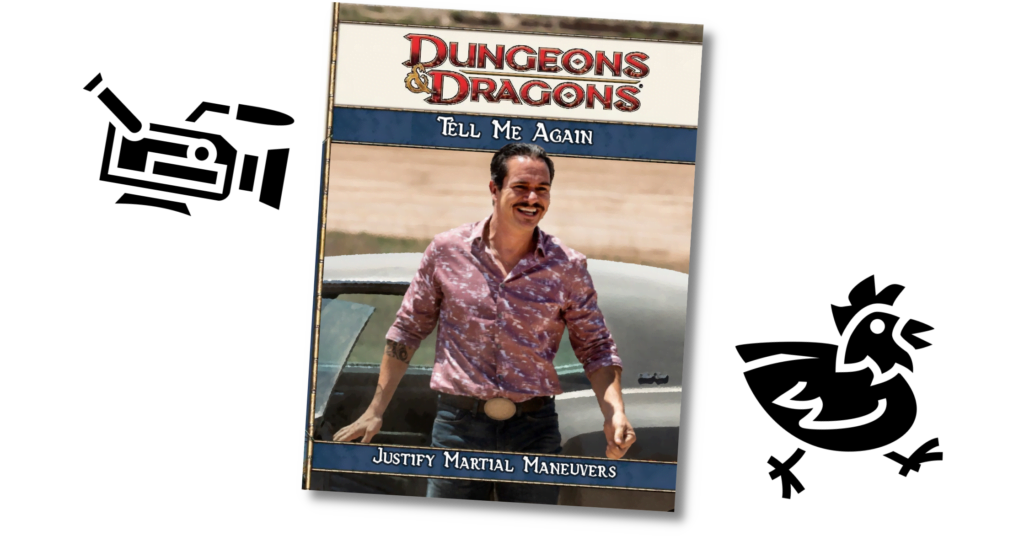In How To Be we’re going to look at a variety of characters from Not D&D and conceptualise how you might go about making a version of that character in the form of D&D that matters on this blog, D&D 4th Edition. Our guidelines are as follows:
- This is going to be a brief rundown of ways to make a character that ‘feels’ like the source character
- This isn’t meant to be comprehensive or authoritative but as a creative exercise
- While not every character can work immediately out of the box, the aim is to make sure they have a character ‘feel’ as soon as possible
- The character has to have the ‘feeling’ of the character by at least midway through Heroic
When building characters in 4th Edition it’s worth remembering that there are a lot of different ways to do the same basic thing. This isn’t going to be comprehensive, or even particularly fleshed out, and instead give you some places to start when you want to make something.
Another thing to remember is that 4e characters tend to be more about collected interactions of groups of things – it’s not that you get a build with specific rules about what you have to take, and when, and why, like you’re lockpicking your way through a design in the hopes of getting an overlap eventually. Character building is about packages, not programs, and we’ll talk about some packages and reference them going forwards.
There’s a real challenge in translating anime characters to other forms of media, and that’s why once again, we go back to the most successful anime of the last five years, which had its grand conclusion just last month. Yes, people love Better Call Saul, and Breaking Bad and then maybe they’ll mention El Camino and maaaybe they’ll mention Slippin’ Jimmy, but no matter how you enjoy it, we all know one of the greatest anime villains of all time stands tall, possibly while murmuring the name Werner… Ziegler…
It’s Lalo!

Spoilers but kinda? For Season 4 and onward of Better Call Saul.
Examining Lalo
I suspect for this one, I’ve given myself something of a tall task to try and justify this one. Because Lalo doesn’t necessarily strike many people as a character who’s a good fit for ‘a D&D game’ or even ‘a player character.’ After all, he’s a villain, and not just a villain, he’s probably going to be one of the iconic villains people are trying to replicate for decades. But even when you set aside whose side he’s on, he’s an ordinary human in the context of a crime drama series that —
can I say it?
— has a bunch of unrealistic fantasy elements. Right? Okay? We can admit it, okay. Breaking Bad feels realistic and the stakes are really high and these are real things that happen but there are a lot of things in it that are godly levels of coincidence and a lot of the characters are blessed by a kind of romantic tension because what matters is how this world feels.
But the thing is, when you want to make a character for you to play in a tabletop campaign, part of the fun is being able to draw on references that aren’t just obvious and easy heroic or fantasy narrative characters, but you may want to show a character to your friends based on the vibe they project. I’ve played a character who I could summarise as ‘stupid sexy Armin Tamzarian,’ and I don’t think it would at all surprise me to imagine sitting down at a table, and hear someone describe their character, as ‘He’s kinda like Lalo Salamanca.’ That’s a useful anchor to express a character, to nail down a vibe.
And what does it mean?
Personally, I’d figure it’s trying to capture the demeanour, the style, the methods of the character of Lalo Salamanca. A very personable, friendly, charming individual, someone who seems very relaxed and chill but whose whole style carries a low, deep threat. They’re charming, and they’re thoughtful, and they’re patient. They notices details, they can convince people to do things, they plan ahead and they have access to resources that let them solve problems.
If we look at Lalo in combat terms, oh, yeah, there’s also the way that literally any time we see him in a fight (with one exception), he just flat out wins. He’s the most dangerous man in the room any time you see him, but also he does it while looking very plainclothes.
But here’s another thing: Lalo is charming. Lalo is capable of manipulating people in a variety of different situations. This can be momentary and abrupt to get someone to put their guard down, or it can be extensive over the course of hours. On the other hand, most of the time he’s dealing with people, there’s threat on the horizon, and that’s going to open up a question in the next section.

The Essential Lalo
First things first, let’s just push a few things off the table. Lalo, at baseline, is probably an entirely martial character. Nothing he does represents special or supernatural powers, and the builds that follow are going to lean on that. We know Lalo is scary with a knife, scary with a gun, and Lalo exists in a space where, as it were, all six of his stats are good. He is quick, strong, tough, quick-witted, perceptive and charismatic. Obviously, we don’t get to just say all of the character’s stats are great, and you don’t want to make it so being good at everything is fundamental to the idea.
What I want to focus on, then, is to try and represent a Lalo who is good at the thing I think is core, and then let that translate to a variety of builds. Because you may conceive of a Lalo who’s an Avenger, or a Paladin, or a Wizard or something, but while you could take Lalo and put him in a robe or armour or a dress or whatever, if when you play them, they can’t be charming and dangerous, it’s probably a miss.
And at this point we need to grapple with three different skills for working with people that have overlaps and exclusions.
- Diplomacy is a skill for convincing people to do what you want them to do while acting in good faith. Diplomacy is about showing people what you want is reasonable. You can use it to be inspiring, comforting or to blend in to a social situation appropriately.
- Intimidate is a skill for convincing people to do what you want them to do or face violence. Intimidate is about convincing people that you are exactly reasonable enough and dangerous enough that if they don’t do what you want, there will be a violent aftermath but if they do, there won’t be. It’s a legitimate skill, because anyone can threaten, but controlling the results is very hard. Intimidate is also useless if you can’t present an actual material threat to the people in question.
- Streetwise is a skill for gathering information and manufacturing leads in a social, connected environment. It’s basically a skill for ‘crimes’ in a broad sense but can also be used to manipulate people into giving up leads, or information, or even opportunities.
Now, chances are, hearing those three descriptions, you probably think Lalo is definitely good at one, or two, or all three. Fortunately, each of these can be optimised by the same ability score and mostly feed into the same kinds of skills and abilities. But it’s not just that, because we also probably need Insight, which feeds off your Wisdom score. Lalo is very insightful, after all.
This pulls us towards needing access to trained skills, and ideally, ways to be good at them.
Now, getting the social skill of your choice is easy, because of the rarely-important character option of Backgrounds. Backgrounds are minor things that rarely are important for most builds, which means that you can use these to push almost any other character option into ‘Lalo-ness.’
- The Wandering Duelist background gives you Intimidate and a +3 to Intimidate checks
- The Street Urchin background puts both streetwise and intimidate on your class skill list and gives you a +1 to both
- The Political Rebel background gives you Diplomacy and Streetwise, and a +1 to both.
- The Waterdeep background gives you an extra language, Diplomacy, and a +3 to Diplomacy checks
- Cormyr gives you Insight, a +2 to insight checks, and a +2 to fear effects
- Redemption Seeker gives you Diplomacy and Insight and a +1 to both
There are also some cheap slotless things that can improve you at a skill, which you can arrange to have with your DM if they’re cool about their impact. Consider something like the Kingslayer’s Curse, which gives you a rarely-used daily power, but also a passive skill bonus you’ll probably want to always track.
Point is, that being good at these skills will make you more able to carry off that Lalo style. These things get to be functionally orthogonal to a lot of other choices. But the thing is, you need a handle on how your Lalo works.
See, Lalo is in numerous points in the story, quite diplomatic. There are some people he deals with in entirely good faith: Do this thing and be paid in return. There are some people who assume there’s a threat, and Lalo takes advantage of that, but at no point in the conversation does he make a threat. Sometimes, he just goes ‘okay,’ and moves on and it’s hard to see that as a threat…
… even if the viewer knows there’s danger there.
Have a vision of how you see Lalo working, and then choose which to include. You could go for just one, you could go for all three. And to make sure that Lalo can be as good at possible at this, I’d look at the classes that can primarily or secondarily benefit from Charisma and who lack for ‘special powers.’

Rogue
The rogue fills a lot of our requirements up front. It doesn’t get any magical powers, it has access to the appropriate skills, and it has a charisma-based build that makes you better at dealing with attacks of opportunity. You’ll need to stick with light blades, slings and hand crossbows (properly gun-like!), and make your basic attack of choice the dex-and-Charisma damage power Sly Flourish.
I feel like this is a good way to show Lalo as a sort of ‘lone threat’ – if your vision of what makes Lalo dangerous is just himself being himself, then this is a good place to start. This isn’t an infrastructural guy – this is a dangerous individual who can make things happen on his own.
Warlord
The Warlord sets you up for Diplomacy and Intimidate, and depending on how you feel about Streetwise, you may need to pick it up with a Background. But the Warlord is an old standard here; you can maximise party members with it, you’re reasonably tough, and you have a good reason to look mostly like a combatant on your own. If what you really liked about Lalo was the way that he could command a room, the Warlord seems a good way to translate that to D&D.
If I was going this direction, I’d probably also invest in the Ritual Caster or Martial Practice feat, and spend some of my budget building out small, rare, utility powers to represent the way that Lalo could react to a lot of oddball scenarios with a cool, calm, ‘I got this’ kind of approach.
Knight
Well, knights get access to Diplomacy and Intimidate. They don’t do a lot with Charisma, though, which may mean this feels like an odd or misplaced option… unless… what’s that?
It’s the werebear’s music!
Look, the synergy between the Knight and the Werebear isn’t exactly super obvious. The most significant thing is that the Knight can trigger effects on basic attacks and the Werebear gives you a basic attack that cares about your best stat. This means you can use this simplified class to make a melee non-obviously armoured character who may not even carry a weapon, who can suddenly, out of nowhere, ripple up into a bear form and maul people’s faces off with the sheer force of his personality.
This is definitely the most ‘urban fantasy’ version of Lalo. I’m sure there’s fanfiction of him as a werebear somewhere, though maybe they give it a weird badly-translated Mexican name, or it relates to the Omegaverse somehow.
Ew.
Anyway, the Werebear is an old favourite of mine with the Knight as a package that kind of sits apart, on its own. There isn’t a lot of feat support for either, but it works from minute 1 and it lets you play a defender that doesn’t look like a normal defender; you could look like, say, a friendly Mexican dad with a floral shirt and an intimidating kind smile.

Junk Drawer
I promise I”m not about to mention the druid.
The thing with Lalo is that because like I said, he’s very much about a vibe, you could put almost anything from the heightened reality of D&D under that same style and it’d feel Lalo-ish. I mentioned the Avenger and Paladin already, because I actually think they’re both really good ways to represent Lalo in a fantasy world with gods and monsters in it. The Salamanca family holds family as paramount, which could be a great basis for a Paladin code. Imagine learning about the party’s Paladin and learning that the seemingly obvious ideals are much more complex, and that they’re part of a network that share their ideology. Seems a great hook for a campaign component.
Plus, the Paladin can be a melee charisma type – using the feat Wrath of the Crimson Legion, you can have this seemingly normal fellow who can punch you in the face with the sheer force of his will that’s fit to break souls.

When you play tabletop RPGs it’s important to remember that the imagination space is big. It’s not just as simple as ‘things that are already like D&D.’ Looking at characters outside of that space can be super helpful for both flexing your mental muscles and considering what about a character is important.
This article was reposted from Talen’s personal blog.
You can find the original at Press.exe
